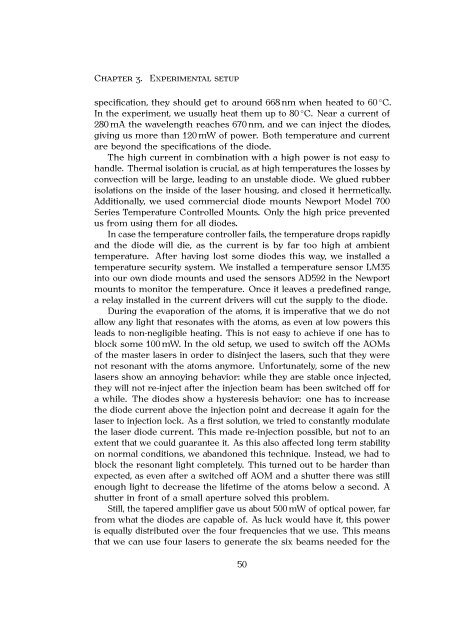Martin Teichmann Atomes de lithium-6 ultra froids dans la ... - TEL
Martin Teichmann Atomes de lithium-6 ultra froids dans la ... - TEL
Martin Teichmann Atomes de lithium-6 ultra froids dans la ... - TEL
You also want an ePaper? Increase the reach of your titles
YUMPU automatically turns print PDFs into web optimized ePapers that Google loves.
CHAPTER 3. EXPERIMENTAL SETUP<br />
specification, they should get to around 668 nm when heated to 60 ◦ C.<br />
In the experiment, we usually heat them up to 80 ◦ C. Near a current of<br />
280 mA the wavelength reaches 670 nm, and we can inject the dio<strong>de</strong>s,<br />
giving us more than 120 mW of power. Both temperature and current<br />
are beyond the specifications of the dio<strong>de</strong>.<br />
The high current in combination with a high power is not easy to<br />
handle. Thermal iso<strong>la</strong>tion is crucial, as at high temperatures the losses by<br />
convection will be <strong>la</strong>rge, leading to an unstable dio<strong>de</strong>. We glued rubber<br />
iso<strong>la</strong>tions on the insi<strong>de</strong> of the <strong>la</strong>ser housing, and closed it hermetically.<br />
Additionally, we used commercial dio<strong>de</strong> mounts Newport Mo<strong>de</strong>l 700<br />
Series Temperature Controlled Mounts. Only the high price prevented<br />
us from using them for all dio<strong>de</strong>s.<br />
In case the temperature controller fails, the temperature drops rapidly<br />
and the dio<strong>de</strong> will die, as the current is by far too high at ambient<br />
temperature. After having lost some dio<strong>de</strong>s this way, we installed a<br />
temperature security system. We installed a temperature sensor LM35<br />
into our own dio<strong>de</strong> mounts and used the sensors AD592 in the Newport<br />
mounts to monitor the temperature. Once it leaves a pre<strong>de</strong>fined range,<br />
a re<strong>la</strong>y installed in the current drivers will cut the supply to the dio<strong>de</strong>.<br />
During the evaporation of the atoms, it is imperative that we do not<br />
allow any light that resonates with the atoms, as even at low powers this<br />
leads to non-negligible heating. This is not easy to achieve if one has to<br />
block some 100 mW. In the old setup, we used to switch off the AOMs<br />
of the master <strong>la</strong>sers in or<strong>de</strong>r to disinject the <strong>la</strong>sers, such that they were<br />
not resonant with the atoms anymore. Unfortunately, some of the new<br />
<strong>la</strong>sers show an annoying behavior: while they are stable once injected,<br />
they will not re-inject after the injection beam has been switched off for<br />
a while. The dio<strong>de</strong>s show a hysteresis behavior: one has to increase<br />
the dio<strong>de</strong> current above the injection point and <strong>de</strong>crease it again for the<br />
<strong>la</strong>ser to injection lock. As a first solution, we tried to constantly modu<strong>la</strong>te<br />
the <strong>la</strong>ser dio<strong>de</strong> current. This ma<strong>de</strong> re-injection possible, but not to an<br />
extent that we could guarantee it. As this also affected long term stability<br />
on normal conditions, we abandoned this technique. Instead, we had to<br />
block the resonant light completely. This turned out to be har<strong>de</strong>r than<br />
expected, as even after a switched off AOM and a shutter there was still<br />
enough light to <strong>de</strong>crease the lifetime of the atoms below a second. A<br />
shutter in front of a small aperture solved this problem.<br />
Still, the tapered amplifier gave us about 500 mW of optical power, far<br />
from what the dio<strong>de</strong>s are capable of. As luck would have it, this power<br />
is equally distributed over the four frequencies that we use. This means<br />
that we can use four <strong>la</strong>sers to generate the six beams nee<strong>de</strong>d for the<br />
50

















